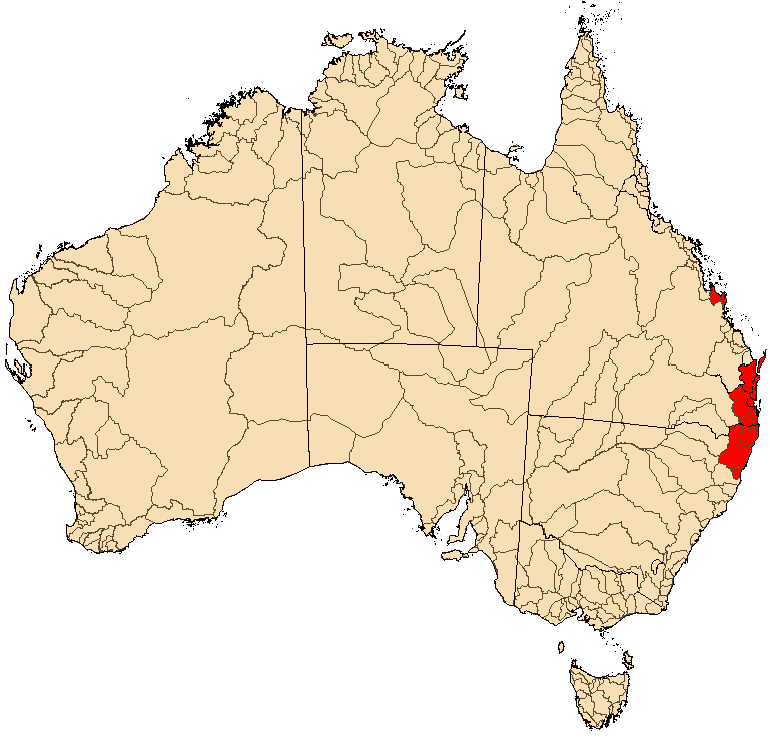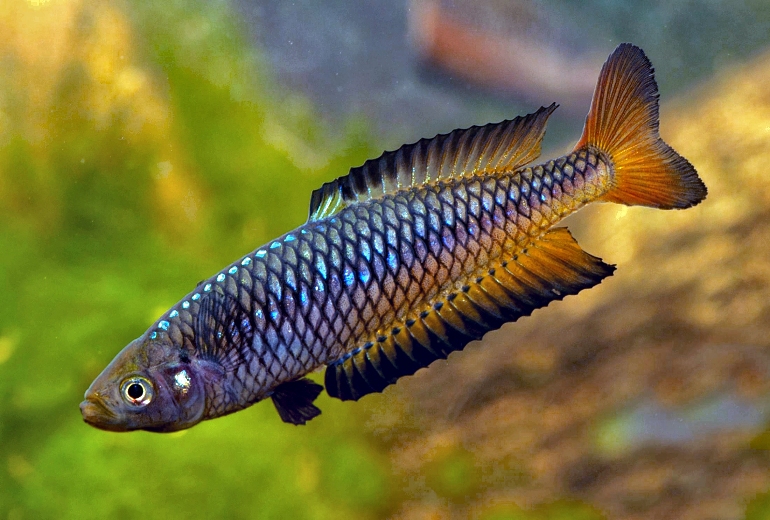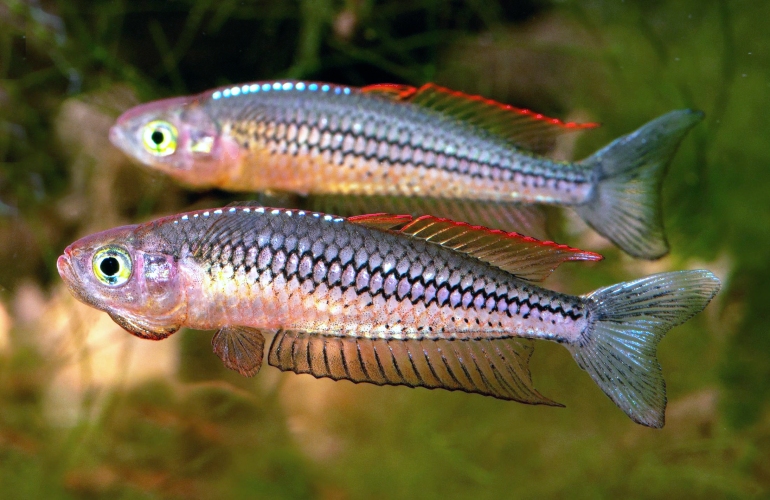 NA.jpg) |
Rhadinocentrus ornatus [Carland Creek, Qld] - photo© Neil Armstrong |
Regan, 1914
Ornate Rainbowfish
Species Summary
Rhadinocentrus ornatus is a small (5-6 cm) freshwater fish species mainly restricted to the coastal 'wallum' habitats of eastern Australia, which is typified by soft, acidic and often tannin-stained water. They were originally collected from Moreton Island, a sand dune island off the Queensland coast in Moreton Bay. The type description of Rhadinocentrus ornatus was from six specimens collected from a pond on Moreton Island by the signal station operator at Cowan Cowan. They were described by Charles Tate Regan at the British Museum of Natural History in 1914. They are the only species currently recognised within the genus. In earlier times they were commonly known as the 'Moreton Island Sunfish' and were very popular with early native fish enthusiasts.
Rhadinocentrus ornatus is a small, slender and relatively elongated species, with two dorsal fins that are very close together; the first much smaller than the second. They exhibit considerable colour variation over their geographical range. Generally the body is semi-transparent with two rows of black scales in the mid-lateral region. The iridescent scales immediately below the dorsal fin and above the lateral line can be either red or metallic pale blue. The dorsal, anal and caudal fins are generally blue (sometimes red) with black edges. In 1995, ANGFA (Qld) members reported collecting an unusual golden-yellow coloured form in the Key Hole Lakes system on Stradbroke Island. Another coloured form on Stradbroke Island showed a distinctive black striped pattern on the sides of the body giving the fish an overall dark colouration of the body. The actual location was not documented.
 GS.jpg) |
Rhadinocentrus ornatus [Evans River Catchment, NSW] - photo© Gunther Schmida |
Body colour can be variable throughout their range with different colours, shades, or patterns. Most populations have their scales outlined with black that form an attractive latticework pattern over the body. However, some populations only show the scale pattern on the dorsal half of the body while the lower half can be either scattered with rounded or oblong markings, or completely clear. Populations from Fraser Island and the Tin Can Bay region in Queensland exhibit a within-population colour polymorphism absent from populations to the south of this region. This polymorphism is comprised of blue individuals whose colouration is generated through iridescent structures on the fins, and red individuals who display varying amounts of carotenoid pigment on the fins and body in addition to iridescent blue colouration, but primarily on the caudal fin (Hancox et al. 2013).
The body can be blue overall or a translucent light brown or olive colour with just a hint of either blue or red. Some males are completely red on the posterior third of the body. The dorsal fin can have a red outer border with black rays or black outer border with blue rays. The caudal fin is usually blue or reddish with a central dark sector. The anal fin usually has a black margin. The blue form is usually light brown on top of the body and fades ventrally to various shades of blue that increase towards the tail. Fish from dark tannin-stained waters can often be very dark. All have scattered iridescent neon-blue spangles of varying densities that run along the back and nape. The different coloured forms can often be found in the same habitat. A third form does not have the black lateral lines or scale pattern and only has iridescent blue scales along the nape. This form is usually smaller than the other varieties. Females are not quite so highly coloured. Males, apart from their brighter colours, can be distinguished from females by having more elongated rays in the second dorsal and anal fins. Males also display a red nuptial stripe running from the upper lip and along the nape to the second dorsal fin during spawning activities.
Rhadinocentrus ornatus can grow to a maximum size of around 7-8 cm total length, but are usually more common at around 5-6 cm. In captivity they have been reported to grow somewhat larger at around 10 cm. However, that is more the exception rather than the rule. R. ornatus tend to develop humped backs and faded colours as they get older and larger.
 |
Distribution Map |
Distribution & Habitat
A 1924 survey of Moreton Island, noted that Rhadinocentrus ornatus were found in swamps and unnamed streams south of the lighthouse. The first report of R. ornatus being found on the mainland that I can find was in an Aquarium & Terrarium Society of Queensland excursion report in 1927. At that time they were known only from Moreton Island. They were found in Belmont (Bulimba Creek), an outer southside suburb of Brisbane. Later that same year they were reportedly found in the Pimpama River catchment (Pimpama Island) on the Gold Coast in southeast Queensland. Members of the Aquarium & Terrarium Society were also the first to discover R. ornatus on Stradbroke Island. They were found in "a little freshwater creek a few miles north of Myora". A description of the creek from the secretary, Amandus Rudel, in 1930 follows:
"The water in this particular creek is very soft and of a slightly brownish colour. Except for a slimy sort of algae, the creek has no under-water plants of any description. No snails or other small insects were to be found and how Rhadinocentrus gets a living is rather a puzzle. The creek is rather narrow but very deep in places and winds its way through a very flat piece of country on the Island. It's really more of a bog and one never knows when the ground gives way. Ferns and sphagnum moss grows all over the flat. Tracks of Kangaroos and Wallabies lead to the creek from all directions, and take it all around it's a very interesting piece of nature."
A description of the fish was given as follows: "Back dark red with a row of blue shining scales. Body yellowish with two rows of black scales and black spots distributed all over body. Dorsal fin red with black edges and the same colour on the anal fin. Tail whitish edged black."
Today we know that Rhadinocentrus ornatus have patchy distribution along the narrow coastal drainages of southern Queensland and northern New South Wales. Its range is nearly continuous amongst the unconnected coastal river catchments from the Nambucca River in the south to the Mary River in the north. North of the Mary River there is a break in the distribution of over 350 km to a disjunct northern population in the Byfield region (Water Park Creek) near Yeppoon. Their distribution includes lake and stream habitats on Bribie, Fraser, Moreton and Stradbroke Islands, a group of islands off the southern Queensland coast.
 GS.jpg) |
Rhadinocentrus ornatus [Teewah Creek, Tin Can Bay] - photo© Gunther Schmida |
Although not endangered, Rhadinocentrus ornatus have a restricted distribution due to urban development and subsequent changes in water quality and/or loss of habitat. Habitat alteration and urban development are still having negative impacts in several areas. Many of the sites at which Rhadinocentrus ornatus are found are in close proximity to dense urban development, which poses a threat to their continued existence. Furthermore, populations near urban areas with degraded habitats have significantly reduced genetic diversity compared to populations from more natural, undisturbed habitats. These consequences could easily lead to the loss of these remaining populations (Mather et al. 2015).
Extensive sampling in rivers and streams of the southeast Queensland mainland over the last few years has yielded relatively few individuals. Rhadinocentrus ornatus was a rare find during a survey of the Nerang River in 2007. Individuals were found both above and below the Heinz Dam. Nevertheless, they can still be found in reasonably numbers in the Sunshine Coast region north of Brisbane.
The introduced mosquitofish (Gambusia holbrooki), which are tolerant of a wide range of environmental conditions may displace native species such as Rhadinocentrus ornatus. G. holbrooki have been reported to prey on their eggs and larvae. R. ornatus have also been observed to switch from areas of open water to refuge areas in the presence of Gambusia. Furthermore, experiments under captive conditions have shown Gambusia to exhibit aggressive behaviour towards R. ornatus.
 |
Rhadinocentrus ornatus [Seary's Creek, Tin Can Bay] - photo© Gunther Schmida |
Rhadinocentrus ornatus congregate in small schools and occupy small, slowly moving creeks and marshy swamps, usually over a sandy substrate. The water temperature range has been reported from 12-32°C. However, they are known to survive water temperatures as low as 8°C. They are most abundant in unpolluted streams, lakes or swampy areas amongst emergent vegetation and reeds of the 'wallum', which is low, sandy, coastal heathland of southeast Queensland and northern New South Wales. These waterbodies are usually very soft and acidic (pH: 3.9-6.8), either clear or more often stained brown or black by prolonged contact with high accumulations of leaf litter and other terrestrial material. The dominance of humic acids among this organic material and the relatively low pH are not conducive to bacterial degradation, so particulate and dissolved humic compounds are metabolised very slowly. The dark colour of the water severely limits penetration of light, which, together with low concentrations of inorganic ions, restricts photosynthetic activity in aquatic plants. Limited photosynthesis and slow bacterial degradation results in low zooplankton and phytoplankton development.
Rhadinocentrus ornatus have also been found in clear rainforest streams with dense overhanging vegetation and leaf litter. In these streams they are usually found around marginal vegetation, submerged logs, or branches. They may be found on their own or with other small-bodied native fishes. Many habitats occupied by R. ornatus also contained individuals of Nannoperca oxleyana and Pseudomugil mellis.
 GS.jpg) |
Rhadinocentrus ornatus [Bribie Island] - photo© Gunther Schmida |
Keeping & Caring
Very little is known about the natural life history and ecology of Rhadinocentrus ornatus in the wild. Most information is mainly based on aquarium observations. During courtship, male Rhadinocentrus ornatus defend small, temporary territories by chasing away rival males. These potential spawning sites are generally part of or close to the stream bank and composed of aquatic vegetation or submerged roots near the top of the water column. Males display to females in front of the spawning site by extending their dorsal and anal fins, and tilting their heads down to reveal a red nuptial blaze, while attempting to lure the targeted female into the spawning area. Evenly sized males also engage in sparring bouts consisting of fin-flaring and circling behaviour, which can escalate into biting and chasing. As in other fish species, small males may elect not to compete, but adopt a 'sneaker' mating strategy and attempt to intercept females at the point of egg release (Hancox et al. 2013). Spawning usually occurs during the warmer period of the year (Spring-Summer) when water temperatures are around 24-32°C. Eggs and larvae have however, been found in the upper Orara River in northern New South Wales during Spring at temperatures of 16-17°C. Eggs adhere to fine-leaved plants or among the roots of floating vegetation.
Rhadinocentrus ornatus have been a popular aquarium fish with Australian native fish enthusiasts for many decades. They are a fish that requires a little more attention than most other rainbowfishes. They can be maintained and bred in water conditions that are suitable for most aquarium species. However, they will survive best if maintained at a temperature range of 20-28°C; pH 6.0-7.0; and water hardness from 5-100 ppm. They will display their best colouration when maintained in a well-planted aquarium of their own, and in a group of around 10 to 20 individuals, particularly if maintained under aquarium conditions that will show their iridescent reflective colouration.
 |
Rhadinocentrus ornatus [Serpentine Creek, Redland Bay Qld] - photo© Gunther Schmida |
Breeding Rhadinocentrus ornatus is similar to most rainbowfishes in captivity. Females spawn small numbers (3-5) of eggs each day. The total number may range from around 20 to 80 eggs over several days. Hatching occurs in about 6-10 days at temperatures between 23-28° Celsius. Hatched larvae are well developed and competent swimmers. Upon hatching the larvae swim at the surface of the water, generally within the upper 1-cm water layer. The mouth is well developed and functional, and they begin feeding within hours of becoming free-swimming. They can be fed commercially available fry foods, newly-hatched brine shrimp, copepods, Infusoria, phytoplankton and microworm.
Rhadinocentrus ornatus characteristically display a considerable range of growth rates, depending on conditions such as food, space, numbers, competition and water temperature. Growth rates of 20 mm in 3 weeks and 30-40 mm in 10 weeks have been reported in captivity with maturity at about 9-12 months. Life expectancy in captivity is around 3-4 years.
Dietary analyses of their natural foods show that they consume a wide variety of aquatic and terrestrial insects, with the greatest proportion of their diet taken from the water's surface (Arthington and Marshall 1999). The main components of their diet consist of terrestrial insects (29-34%), Aquatic dipterans (16-24%), Copepods (8-11%), Cladocerans (0-6%), Ostracods (5-9%), Decapods (0-2%), algae or pollen, mostly pollen (6-32%), seeds (0-1%), aquatic acarinids (0-1%), and miscellaneous organic matter (0-7%). Small quantities of filamentous algae are also consumed (Arthington et al. 1990).
GES.jpg) |
Rhadinocentrus ornatus [Mount Cotton, Qld] - photo© Gunther Schmida |
Literature
Aquarium and Terrarium Society of Queensland Archives 1926 - 1938.
Arthington A.H., M. Kennard and G.J. Miller (1990) Water quality and trophic status of Fraser Island lakes. Final report, Part A. Division of Environment, Queensland Department of Environment and Heritage.
Arthington A.H. and C.J. Marshall (1999) Diet of the Exotic Mosquitofish, Gambusia holbrooki, in an Australian Lake and Potential for Competition with Indigenous Fish Species. Asian Fisheries Science 12:1-16.
Coaldrake J.E. (1961) The ecosystem of the coastal lowlands ("wallum") of southeast Queensland. Bulletin 283 (CSIRO: Melbourne).
Coaldrake J. E. (1962) The coastal sand dunes of southern Queensland. Proceedings of the Royal Society of Queensland 72: 101-115.
Hancox D., C.J. Hoskin and R.S. Wilson (2010) Evening up the score: sexual selection favours both alternatives in the colour-polymorphic ornate rainbowfish. Animal Behaviour 80: 845-851.
Hancox D., R.S. Wilson and C.R. White (2013) Visual habitat geometry predicts relative morph abundance in the colour-polymorphic ornate rainbowfish. Proceedings of the Royal Society B: Biological Sciences, 280: 1-7.
Marshall J.C. (1988) An extension of the known range of Rhadinocentrus ornatus. Fishes of Sahul 5: 196-197.
Mather A., D. Hancox and C. Riginos (2015) Urban development explains reduced genetic diversity in a narrow range endemic freshwater fish. Conservation Genetics 16: 625-634.
McKay R. & J. Johnson (1990) The freshwater and estuarine fishes, In: The Brisbane River: A source book for the future, Davie P, Stock EC and Choy DL (Eds), pp 153-168, Australian Littoral Society, Brisbane, Australia.
Page T.J., S. Sharma and J.M. Hughes (2004) Deep phylogenetic structure has conservation implications for ornate rainbowfish (Melanotaeniidae: Rhadinocentrus ornatus) in Queensland, eastern Australia. Marine and Freshwater Research 55: 165-172.
Page T.J. & J.M. Hughes (2007) Phylogeographic structure in an Australian freshwater shrimp largely pre-dates the geological origins of its landscape. Heredity 98: 222-231.
Pusey B.J., M.J. Kennard and A.H. Arthington (2004) Freshwater Fishes of North-Eastern Australia. CSIRO Publishing, Victoria.
Regan C.T. (1914) Report on the freshwater fishes collected by the British Ornithologists' Union expedition and the Wollaston expedition in Dutch New Guinea. Transactions of the Zoological Society of London: 275-286.
Sharma S. & J. M. Hughes (2011) Genetic structure and phylogeography of two freshwater fishes, Rhadinocentrus ornatus and Hypseleotris compressa, in southern Queensland, Australia, inferred from allozymes and mitochondrial DNA. Journal of Fish Biology 78: 57-77.
Adrian R. Tappin
Updated March, 2016



|

